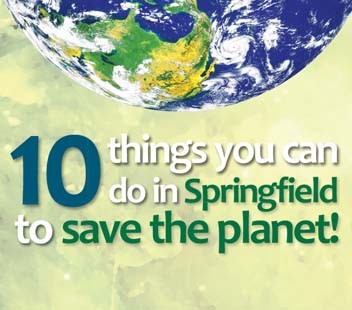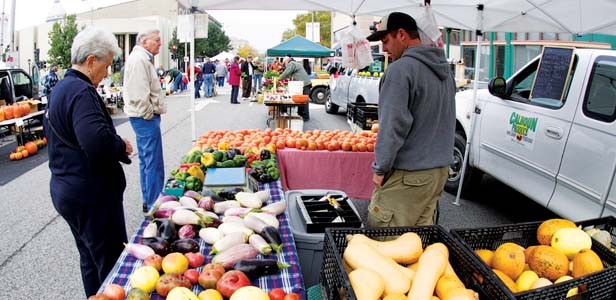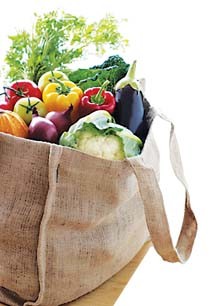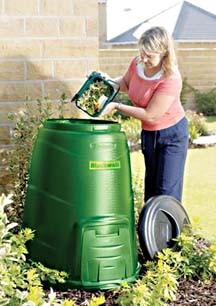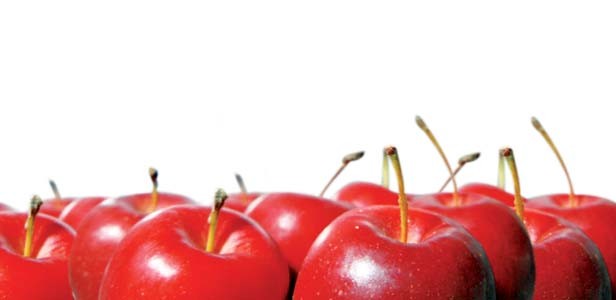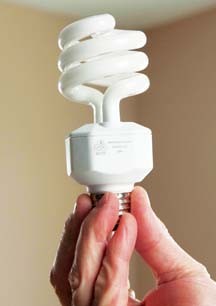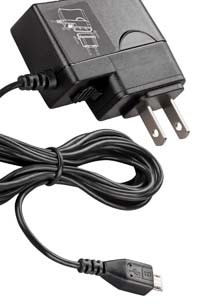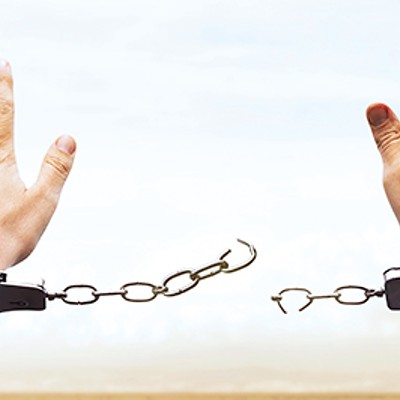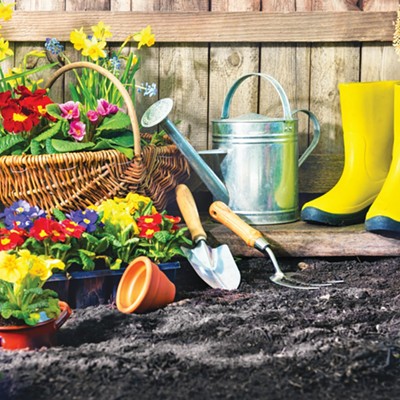The Earth Day issue: Save. Simplify. Grow. Make a difference.
You don’t have to be Captain Planet, Al Gore or Rachel Carson to help the environment. Saving energy, preserving natural resources and reducing waste are easier than you think! Small changes in your lifestyle can have positive results for the planet, your pocketbook and your soul.
This issue of Illinois Times features tips and tricks to help you help save the planet, from Springfield. Inside, you’ll find ways to reduce waste, from reusable grocery bags and cloth diapers to instructions for building your own compost pile. Save green while going green by doing a home energy audit, driving the speed limit and unplugging electronics when they’re not in use. We’ve also included Earth Day activity ideas for adults and kids alike.
Connecting with the earth through gardening is a healthy and fun component of a planet-friendly lifestyle. Get started by planting a tree that will outlive you, soak it with water from a rain barrel and enter your garden in this year’s Springfield in Bloom competition.
Join us in celebrating our planet this Earth Day. In Springfield, we have many opportunities to reduce, reuse and recycle. As a community, we can make a difference, one small step at a time. –Diane Ivey
1. Paper or plastic? Neither!
Using durable cloth bags to save the planet
One of the pillars of the environmental movement is reducing consumption, so it’s fitting that you can reduce consumption of something that helps bring home your consumables.
We’re talking bags – reusable cloth bags, as opposed to the paper or plastic bags you’ll find at practically every store, from the supermarket to the mall. Putting your purchases in a cloth bag instead of paper or plastic cuts down on the oil used in plastic bag production, trees cut down for paper bags and the huge volume of trash they both create when thrown away.
And let’s be honest: using cloth bags helps you avoid stuffing the countless plastic bags you can’t bear to throw away into every empty cupboard nook and closet cranny.
Sure, it can be a hassle to remember your cloth bags every time you go shopping, but the alternative is contributing to the estimated 100 billion plastic bags used in the United States each year, which require an estimated 12 million barrels of oil to produce. Only about one to three percent of those bags are recycled; the rest end up elsewhere — in landfills, tangled in trees and fences or floating out on the open ocean. Research suggests those plastic bags take 1,000 years to biodegrade, presenting a choking hazard to animals and making environments into eyesores.
Think paper is better? Think again. It takes up to four times as much energy to produce a paper bag as a plastic bag and almost 100 times as much energy to recycle. It also includes the use of millions of gallons of toxic chemicals and as many as 14 million trees each year to produce enough paper bags for the United States.
Considering all of that, why not grab a handful of durable cloth bags and let the stores keep their paper and plastic?
–Patrick Yeagle
2. Slow and steady
Driving slower to save on gas mileage
Modern life is busy. Not even counting work, you’ve got to take the kids to swimming lessons at the YMCA, visit your favorite aunt’s art display at the Hoogland Center and get to your CrossFit classes at FitClub, all before rounding up the family to bond over dinner together.
Considering how rushed we often feel, it may be tempting to drive a bit faster than we’re supposed to – 40 miles per hour instead of 30 on Sangamon Avenue, 55 instead of 45 on Wabash and even 65 instead of 45 on Veterans Parkway. But consider this: besides breaking the law when you speed, you’re wasting gas, which ultimately hurts the environment.
Gas mileage is the key. Depending on your car, for every five miles per hour over 60 you drive, you sacrifice between seven and 23 percent of your fuel efficiency, according to the U.S. Department of Energy. In monetary terms, slowing down can mean saving up to 24 cents per gallon. That’s like getting a free gallon of gas for every 12 gallons you use carefully.
Slowing down for the environment can have big effects in the long run. Though a gallon of gas only weighs about six pounds, it creates about 19 pounds of carbon dioxide when burned and combined with oxygen. For the average American driver covering 12,000 miles per year, getting 25 miles per gallon instead of 20 can keep 1.2 tons of CO2 out of the atmosphere each year. (12,000 miles / X mpg * 20 lbs. of CO2 / 2,000 lbs. = tons of CO2 per driver per year) The same equation shows that going from 15 mpg to 20 can save four tons of CO2 each year.
And while you’re at it, stay calm behind the wheel. Driving aggressively – rapid acceleration and braking – can waste between five and 33 percent of your fuel efficiency, costing you up to an estimated 91 cents per gallon. Remember, going easy on the gas means taking it easy on the planet.
–Patrick Yeagle
3. Composting 101
A quick guide to greener gardening
Compost is a great way to feed your garden this spring. Dead leaves, vegetable scraps and other organic waste can be used to make rich, fertile topsoil ideal for plants and flowers.
A compost pile can be built on bare ground or inside a bin. If built on the ground (not on asphalt or cement), the pile should be on top of a wooden pallet to allow for proper air circulation. You can also build your own compost bin using concrete blocks, salvaged wood or a garbage can with a secure lid.
Either way, your compost will need four things to thrive: air, water, brown organics (like dead leaves, twigs and manure) and green organics (lawn clippings, weeds, garden refuse and vegetable/food scraps). To build the pile, add a layer brown organics 6-8 inches thick, followed by a layer of green organics and a third layer of topsoil or a starter material like animal manure. Repeat this layer once more for appropriate size. Compost piles should be no smaller than a three-foot cube, and no larger than a five-foot cube.
Most compost piles should be turned about once a week, or when new material is added. Once the materials decay enough to form dirt, it’s ready to be added to the landscape. Compost may be added to garden soil in a three- or four-inch layer, and then tilled with existing soil. You can also add a three-inch layer of compost as mulch for flower beds, vegetable gardens or around trees and shrubs. Houseplants can also use compost, when it’s spread in a thin, sifted layer on top of their soil.
The City of Springfield allows backyard composting, but piles must be contained in a free-standing bin no larger than the five-foot cube. Bins must be no less than three feet away from all property lines and structures, and can’t be located in alleyways. No manure can be composted within city limits.
For more information, contact the City of Springfield Division of Waste & Recycling at 217-789-2327 or online at www.springfield.il.us/recycle.htm.
—Diane Ivey
4. The dirty dozen
Pick your organic produce with this easy list
5. Raise green kidsBuying organic or local produce is a great way to support your community as well as the green movement. However, buying everything fresh from the farm can be pricey. If you’re perusing the farmers markets and grocery stores this spring, here’s a handy guide for organics worth investing in.
The so-called “dirty dozen” are the products most likely to be contaminated by pesticide residues, thus the best ones to buy organic. The Environmental Working Group, a nonprofit research organization, came up with this list in 2006. If you can’t afford to buy everything organic, these are the items you should probably invest in first.
A good rule of thumb is: if it has a thin skin, buy organic. Something like a banana, however, has a thick skin, and so the food inside the skin is less susceptible to pesticides or other contamination. If you’re looking to save money, buy your thin-skinned products locally and your thick-skinned fruits and veggies wherever you’d like.
All information courtesy of the Environmental Working Group. www.ewg.org.
—Diane IveyThe dirty dozen. Better buy organic:
- Peaches
- Apples
- Sweet Bell Peppers
- Celery
- Nectarines
- Strawberries
- Cherries
- Pears
- Grapes (imported)
- Spinach
- Lettuce
- Potatoes
The 12 safest to buy anywhere:
- Onions
- Avocado
- Sweet corn (frozen)
- Pineapples
- Mango
- Asparagus
- Sweet peas (frozen)
- Kiwi fruit
- Bananas
- Cabbage
- Broccoli
- Papaya
Eco-friendly activities to celebrate Earth Day
Celebrate Earth Day and your children’s creativity by cooking up a few family-friendly snacks in the kitchen.
Kim Leistner, founder and president of Springfield Moms, offers dirt pudding as an easy, fun recipe that also gives parents a chance to explain the importance of recycling.
Combine two cups of cold milk and one 4-ounce package of instant chocolate pudding in a bowl and mix for two minutes. Let it sit for five minutes, and then stir in one 8-ounce tub of thawed whipped topping and half of a 16-ounce bag of crushed, chocolate sandwich cookies. Fill plastic biodegradable cups with the pudding mixture, and then top with remaining cookie crumbles and gummy worms or insects. Voil — dirt pudding.
“It’s important to do age-appropriate things with them, and it doesn’t have to be anything fancy,” Leistner says. “That’s what’s so great about it.”
She recommends do-it-yourself trail mix if you’re planning to take your kids on a nature hike in nearby Washington Park or Lincoln Memorial Garden. It’s healthy, she says, and lets kids pick their own ingredients.
Set out bags of pretzels, raisins, peanuts, Cheerios and M&M’s — or any other handy snack. Encourage your kids to decorate and then fill their own brown paper bags with their special Earth Day concoction.
Trail mix also makes for a great take-along snack, Leistner says, when she walks with her two daughters through their neighborhood to pick up trash. Whether it’s for Earth Day or any day, they just put on gloves, grab an extra grocery bag and go.
“Walking around the neighborhood and filling up bags with trash opens their eyes to the little things they can do to help,” she says.
–Amanda Robert
For more ideas on getting your kids involved in Earth Day, visit the Springfield Moms’ Green Living section at www.springfieldmoms.org.
6. Energize your home
Save money with a home energy audit
While green building has become more and more popular, most of us live in homes built before energy efficiency was a priority. An energy audit is a great way to determine how best to save on utility bills in your home.
The auditor will inspect your home from basement to attic, checking your insulation, caulk, weatherstripping, doors, windows and lighting and other appliances. They will also do an air-blowing test (using a fan they attach to an exterior door) to find out if you have any drafts, and if so, where they are coming from. At the end of the audit, the expert will give you a list of energy-efficient providers or products, depending on your needs.
Here are some local places to get an energy audit:
City Water, Light and Power does home energy audits for $25. If you make any of the suggested improvements within a year of the audit, you can get the original fee back in a rebate. 217-789-2070, www.cwlp.com, [email protected]
Home Energy Solutions is a privately owned local company that offers audits for varying prices, depending on the size of the home. 217-528-3739, www.energysolutionsnow.com, [email protected].
Springfield Electric also does home energy audits. 217-788-2100, www.springfieldelectric.com, [email protected]
The Green Center at Lincoln Land Community College has information on how to get an energy audit if you can’t afford one. There’s a U.S. Department of Energy service that offers weatherization services to low-income families. If you think you might qualify, or want to learn more, check it out here: http://llcc.edu/greencenter
If you’re the do-it-yourself type, you can perform your own energy audit using the National Trust for Historic Preservation’s checklist at www.preservationnation.org.
The Home Energy Saver is a Web-based tool that allows you to calculate your current energy use and potential savings, available at http://hes.lbl.gov/.
—Diane Ivey
7. Greener baby’s bottom
A new generation of cloth diapers
Despite fears that they’re messy, unsanitary and difficult to use, cloth diapers are making a comeback.
Sheri Hays, a local speech pathologist turned stay-at-home mom, switched to cloth diapers when her daughter was just a few months old. The baby had sensitive skin, Hays says, so she wanted to find diapers without chlorine or other chemicals.
“The cloth diapers have definitely been gentler on her skin,” she says, “and she seems to prefer wearing the cloth.”
Cloth diapers aren’t the same pieces of fabric secured by safety pins that your mothers and grandmothers used. They’re modern, available in bright colors and prints and meet a variety of parental and baby needs.
Here’s just a sample of what’s out there:
Prefold diapers are rectangular pieces of cotton or other fabric that come lined with absorbent material and call for separate waterproof covers.
Fitted diapers come with straps that can be adjusted as your baby grows from infancy to toddler years.
All-in-one diapers have attached waterproof outer covers that snap closed and are bulkier for better absorbency.
Pocket diapers are made with fleece or other soft material and can be fitted with individual, absorbent inserts.
Another plus for Hays, and for many other parents, is the ability to reuse cloth diapers. Instead of sending them to the landfill, empty diapers of solids and store them in a covered container. When you’ve stockpiled enough dirty diapers, throw them in the laundry machine and start with a pre-wash of cold water. Finish with a hot wash with laundry detergent. Expert moms agree that there’s no need to worry — hot water and soap kills any germs and bacteria.
“We were a little nervous at first about cleaning the diapers, but we have not had any trouble with this at all,” Hays says. “We now have another daughter and we are using the cloth diapers on her as well with positive results.”
—Amanda Robert
8. Put it all on the line
Save energy with your laundry
Sooner or later, no matter how long you put it off, you’re going to have to do laundry. Here are some quick tips that will save energy and make your wash more earth-friendly.
Don’t over-dry. Over-drying can waste a ton of energy, and consequently cost you money! If you’re operating a dryer at your house, find out exactly how long you’ll need, so you can pull your clothes out without wasting time. If you’re an apartment-dweller, this is harder because some dryers don’t let you start them again if you open the door halfway through the cycle. Unless you’re drying super-heavy fabrics, you probably won’t need a full hour. If you go with the recommended medium-sized load, your clothes should be done in abut 40 minutes.
Air dry any remaining damp items. Cotton items like towels and underwear tend to dry pretty quickly. Take those out about 30 minutes into the cycle, and finish the laundry with the remaining items. This will dry your other clothes quicker. Put your still-damp clothing over a chair or table. In the morning, they’ll be dry and you can wear them to work or school. It’s not like you’re going to fold your laundry right away anyway.
Don’t overload the machine. This seems like common sense, but people do this all the time. Don’t stuff every hooded sweatshirt you own, plus bed sheets and dress pants into one machine. Overloading the machine means you’ll spend more time washing and drying, thus you’re wasting energy. Unnecessary. Some washers will tell you not to fill past a certain point, but the bottom line is: if you’re struggling to fit everything in, there’s a problem.
–Diane Ivey
9. Commune with nature
Adopt a wild bird to Celebrate Earth Day
Earth Day revelers searching for a specific specimen to celebrate can check out International Migratory Bird Day — an annual event that calls attention to bird migration in the United States, Canada, Mexico, Central and South America and the Caribbean — at Adams Wildlife Sanctuary in Springfield this Saturday, April 24.
Vern Kleen, a retired avian ecologist with the Illinois Department of Natural Resources, will man the Margery Adams Bird Banding Station from 9 a.m. to noon. He’ll collect birds from thin mist nets that are scattered throughout the sanctuary and bring them to the station to identify, measure and weigh. He’ll affix a band to their leg, and maybe even let you hold one before he releases it back into the wild.
Visitors will get the chance to “adopt” a bird — and if your bird is ever re-caught, you’ll get a letter from Kleen telling you when and where it was found. In just one three-month bird banding session last spring, Kleen identified 81 different species and nearly 1,500 total birds.
Jo Skoglund, membership/volunteer development coordinator for the Illinois Audubon Society, says Kleen’s work is the major draw because visitors “see birds up close and learn about bird banding.”
At 10 a.m. and 11 a.m., sanctuary staff will lead nature hikes to identify birds, trees and plants along the property’s one-mile trail. Throughout the day, visitors can also play the Migration Game on the shorter, quarter-mile trail. The goal is to successfully migrate by completing all 25 stations, but Skoglund warns that some birds won’t make it — that’s just how migration is.
“It’s fun for families,” she says, “and it’ll be encouraging to get people to do the trail.”
Sanctuary staff will also offer face-painting and temporary bird tattoos for kids.
—Amanda Robert
For more information on International Migratory Bird Day, visit www.birdday.org.
10. Pull the plug
Using your electronics to save energy
As the lights go out at bedtime, they reveal themselves: tiny colorful lights that serve as reminders of the blessings we take for granted. They are our cell phone chargers, computers and other assorted luxuries many of us leave plugged in and turned on constantly. They are symbols of our nation’s wealth and luxury, but they are also big drains on our wallets and our environment.
Because many modern appliances and machines draw power even when turned off, leaving them plugged in when not in use can raise your home’s energy consumption by as much as 20 percent, according to the U.S. Department of Energy. Your TV, VCR, DVD player and even some coffee makers use energy on stand-by, so weaning them off the juice helps reduce our nation’s reliance on non-renewable resources like coal, natural gas and oil that pollute the environment. And let’s be honest: how many of us ever figure out how to program our VCR or DVD player anyway?
To get started saving energy, do a sweep of your home, going room to room looking for anything with a light or that feels warm to the touch. Some electronics, like your TV, may not have a light or be warm, but it’s still smart to pull the plug.
And when we say “pull the plug,” it doesn’t have to be literal. You don’t have to sacrifice all the convenience of constant power if you invest in a few good power strips that have on/off switches. Using those will allow you to turn off entire banks of electronics when not in use.
And next time you’re looking at a shiny new laptop (or any electronic device or appliance), consider one that carries the EnergyStar logo. You’ll save money in the long run and help keep our world beautiful.
–Patrick Yeagle

